|
|
|
|
|
|
|
|
|
|
|
|
|
|
|
|
|
|
|

|
Current Exhibitions Future Exhibitions Back to Exhibitions Exhibition Checklist 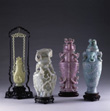 Left to right: Hanging vase suspended by an interlinked chain with upward curling qilong (immature dragon), late Qing to early Republic, late 19th to early 20th century, nephrite, 11.75 x 3.25 x 1.5 in.; Covered vase with blooming shubs, bamboo and flying birds, Qing, late 18th century, nephrite, 11 x 5 x 3.25 in.; Covered vase in the archaistic style after hu vessel with zoomorphic figures, Qing, late 19th to early 20th century, jadeite, 12.25 x 4.75 x 2.25 in.; Slender vase with cover in the archaistic style with stylized animal masks, Qing, 19th century, jadeite, 12 x 4.5 x 2.75 in. All pieces in The Dr. James R. and Ann Peltier Collection
Left to right: Hanging vase suspended by an interlinked chain with upward curling qilong (immature dragon), late Qing to early Republic, late 19th to early 20th century, nephrite, 11.75 x 3.25 x 1.5 in.; Covered vase with blooming shubs, bamboo and flying birds, Qing, late 18th century, nephrite, 11 x 5 x 3.25 in.; Covered vase in the archaistic style after hu vessel with zoomorphic figures, Qing, late 19th to early 20th century, jadeite, 12.25 x 4.75 x 2.25 in.; Slender vase with cover in the archaistic style with stylized animal masks, Qing, 19th century, jadeite, 12 x 4.5 x 2.75 in. All pieces in The Dr. James R. and Ann Peltier Collection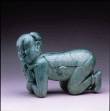 Pillow in the shape of a crouching boy (wawachen), Qing, Qianlong reign (1736-1795), jadeite, 8.5 x 12.75 x 5 in. The Dr. James R. and Ann Peltier Collection
Pillow in the shape of a crouching boy (wawachen), Qing, Qianlong reign (1736-1795), jadeite, 8.5 x 12.75 x 5 in. The Dr. James R. and Ann Peltier Collection
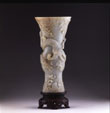 Vase after a gu vassel with a dragon pursuing a flaming pearl, Ming, late 16th to early 17th century, nephrite, 10.75 x 5 x 4 in.
Vase after a gu vassel with a dragon pursuing a flaming pearl, Ming, late 16th to early 17th century, nephrite, 10.75 x 5 x 4 in.
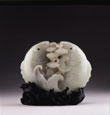 Pair of arching carp in pursuit of a flaming pearl, Qing, second half of 18th century, nephrite, 5.5 x 7.5 x 2.5 in. The Dr. James R. and Ann Peltier Collection
Pair of arching carp in pursuit of a flaming pearl, Qing, second half of 18th century, nephrite, 5.5 x 7.5 x 2.5 in. The Dr. James R. and Ann Peltier Collection
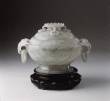 Covered bowl in the Moghul style with chrysanthemum handles, n.d. Jadeite, 6.5 x 9.75 x 7.6875 in. The Dr. James R. and Ann Peltier Collection
Covered bowl in the Moghul style with chrysanthemum handles, n.d. Jadeite, 6.5 x 9.75 x 7.6875 in. The Dr. James R. and Ann Peltier Collection
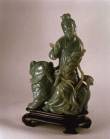 Bodhisattva Manjusri (Pusa Wenshu) sitting on a lion, Qing, last quarter of 19th to first decade of 20th century, jadeite, 11.5 x 6.875 x 4.5 in.
Bodhisattva Manjusri (Pusa Wenshu) sitting on a lion, Qing, last quarter of 19th to first decade of 20th century, jadeite, 11.5 x 6.875 x 4.5 in.
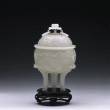 Covered tripod vessel (ding) in the Moghul style with schematic floral arrangements, Qing, late19th century, nephrite, h. 5.5 x dia. 3.25 in. with lid. The Dr. James R. and Ann Peltier Collection
Covered tripod vessel (ding) in the Moghul style with schematic floral arrangements, Qing, late19th century, nephrite, h. 5.5 x dia. 3.25 in. with lid. The Dr. James R. and Ann Peltier Collection
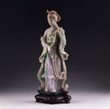 Flower-gathering lady (xiannu), early Republic, first half of 20th century, jadeite, 10.25 x 4.25 x 2.25 in. The Dr. James R. and Ann Peltier Collection
Flower-gathering lady (xiannu), early Republic, first half of 20th century, jadeite, 10.25 x 4.25 x 2.25 in. The Dr. James R. and Ann Peltier Collection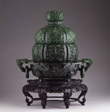 Covered lobated double-tiered incensor with open-work of Buddha's rose (baoxianghua) motif, Qing, late 19th century, nephrite, 11.375 x 12.625 x 9.5625 in. The Dr. James R. and Ann Peltier Collection
Covered lobated double-tiered incensor with open-work of Buddha's rose (baoxianghua) motif, Qing, late 19th century, nephrite, 11.375 x 12.625 x 9.5625 in. The Dr. James R. and Ann Peltier Collection
|
Treasures of Heaven and Earth: The Dr. James R. and Ann Peltier Collection of Carved Chinese Jade August 5–September 26, 2004 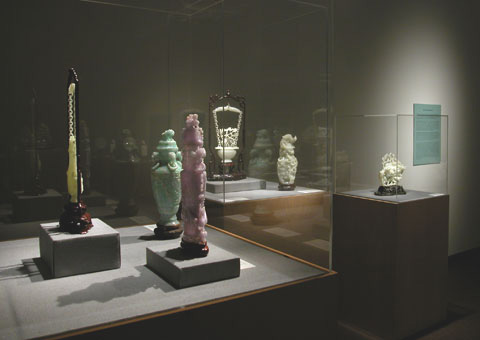
The Tyler Museum of Art is pleased to present Treasures of Heaven and Earth: The Dr. James R. and Ann Peltier Collection of Carved Chinese Jade, an exhibition comprising more than 60 exquisite works of art on loan from collectors Dr. James R. and Ann Peltier of Thibodaux, Louisiana. With extraordinary works dating from the Qing Dynasty (1644–1912) and the earlier dynasties of Ming (1368–1644), Song (960 - 1279), and Han (206 B.C.–220 A.D.), this exhibition provides a rare opportunity to explore the exotic and mesmerizing beauty of jade and its esteemed place in Chinese culture. Masterfully carved jade in the shape of vessels and animals and as ritual, decorative and scholar's objects will be on view in the North Gallery from August 5 through September 26, 2004. Dr. Peltier began his jade collection in the mid-1970s with the purchase of a beautiful slender covered vase in the archaistic style. Two years later, when he bought a second equally superb but very different piece, jade became a passion in a way only true collectors know: "I became hooked," Dr. Peltier claims. That piece was shaped as a pair of arching carp in pursuit of flaming pearl symbolizing, among other things, marital bliss. Although Dr. Peltier describes his collection as eclectic, his interest is definitely in the Qing period, even more so than the Ming. He favors jade from the Qianlong reign (1736–1795) in the Qing dynasty when jade production flourished with advances made in carving skills and technical innovations. Having been a maxillofacial surgeon, Dr. Peltier has a greater respect for three-dimensional form than for the two dimensions associated with paintings. In this brochure we are fortunate to have him share with us his knowledge of and passion for jade. In 30-odd years since acquiring their first piece, Dr. and Mrs. Peltier have built a jade collection of incomparable beauty rivaling the best in this country. The Tyler Museum of Art is very grateful to the Peltiers for the opportunity to display their cherished collection in Tyler. Our gratitude is extended to the Louisiana State University Museum of of Art, to which the Peltiers have gifted a portion of their collection, for the loan of eight pieces to this exhibition. The Museum also thanks Robert and Mary K. Peltier of Tyler for directing us to this marvelous collection. Jade: The Great Stone James R. Peltier The very mention of the word jade conjures up mystery and intrigue. Though it isn't actually mystical, jade does possess many remarkable properties. It is hard and durable (a hardness of approximately 7, compared to diamond at 10 on the Moh's scale). It is lustrous and has musical resonance when struck against other jades. Because it is a non-conductor, jade transmits a special response to the tactile sense. This marvelous substance comes in an amazing number of colors. Goette lists a spectrum of 70 colors from white to black. In its purest form jade is white. All other colors are derived from inclusions of various minerals. There are essentially two forms of jade: nephrite, a magnesium silicate; and jadeite, a silicate of aluminum and sodium. Microscopically, nephrite consists of a fibrillar pattern and jadeite is composed of a crystalline design. Nephrite is usually white or in various hues of green, whereas jadeite is generally found in a greater variety of colors. Though structurally and chemically different, they are both identified as jade. Nephrite is slightly tougher than jadeite, and jadeite is slightly harder. In evaluating a piece of carved jade, several points must be considered. In the final analysis, however, creativity and workmanship, good color, age, large size and translucency are the marks of quality. Full appreciation comes when one views a carving in its entirety, noting artistic expression and harmonization, which implies utilizing different colors inherent in the stone to greatest advantage. In former times as well as in the present, the master carver directed the operation of cutting jade. The master carver was the true artist of the studio - a master planner, a designer and a "painter." Like a painter, he had to have a "feel" for the light and the dark, as well as the colorful areas within the stone. Often he would take advantage of the skin or rind of the stone and incorporate it into the rendition. Most of all, he had to understand the jade, be able to examine the raw material and evaluate what could be carved from the stone, while preserving as much of the mass as possible. He had to visualize the final results before carving began, but it was also necessary that he be able to adjust the design when unforeseen properties or colors manifested themselves. He was a frequently underrated master artist of his time. Since at least 3000 B.C., the Chinese have had a deep reverence for jade. Jade bridged the distance between heaven and the emperor, the Son of Heaven. Other cultures held similar fascination for and attraction to jade. It was highly prized in New Zealand and Central America, and in Mexico, it is said that Montezuma smiled when he learned that the conquistadors were interested only in gold, not in jade. In ancient times and up through the last Chinese dynasty, jade had a wide variety of uses. It was carved into personal, home and palace adornments. It was also a part of religious and ceremonial services. It was used for musical chimes, in gaming, as a fondling stone, as pillows, slippers, imperial seals, as medicaments, for weapons, as libation and eating vessels, for work instruments, and even in barter. In funerary rituals, it was placed in the tombs of the wealthy. In some burials, jade was inserted in the nine apertures of the body to repel evil spirits. But today, jade is used only as jewelry and as a decorative art form. Carvings in Chinese jade are generally symbolic, often depicting a religious scene or substituting animals, signs or flowers to represent a wish, such as connubial bliss, fertility or long life. Jade carvings from the Ming Dynasty (1368–1644) are "special." During this period, jade was more dull than colorful, usually motley and rarely translucent in contrast to the jade of the Qianlong Period (1735–1796). These handicaps became challenges to the master carver. The artist often created a masterful and powerful design in order to conceal unattractive areas in his material. Ming carvings were almost always traditional, such as incense burners, vases and stylized animals. Some of the warmest and most spiritual carvings of fluidity in jade were produced then. During the late Qianlong Period, some of the world's greatest jade works were created. All the right ingredients were there. Building on the tradition and skill of the Ming, these artists had the additional stimulus of Emperor Qianlong himself. He was undoubtedly the greatest collector of art in the history of the world. Throughout his reign, he was patron of the many fine workshops in the Forbidden City. With his encouragement, the Imperial craftsmen introduced a blend of modernizing styles to ancient forms. With more colorful stones and with more freedom, the carvers established the lavish techniques of great embellishment, which culminated in the ultimate aesthetic creations. Dating jade is a field of study unto itself. Carbon dating processes do not work because jade contains no organic material. Reign marks mean little as they were often added at a later date. Only when tombs of known periods are excavated can the jade findings be precisely dated; otherwise, attaching a period to a piece of jade is mostly speculation. Age is relatively meaningless as far as jadeite is concerned because almost all of the oldest pieces do not predate the 19th century. In determining a date, for example, "white mutton-fat nephrite" rarely existed prior to the Qianlong Period and was rarely found in the 20th century; therefore, spectacular white colors can usually be pinpointed to the 18th or 19th century, but style of carving remains the determining factor. Further, pieces of the colorful Burmese jadeite—lavender, emerald, etc.—were infrequently seen before 1800. [Wills, Geoffrey, Jade of the East (John Weatherhill, Inc.: 1972, p.88)] When one of these is observed, we know it was fashioned in the 19th or 20th century. Also, the carvings of the present century lack a certain patina. While some writers consider it lamentable that jade carvings cannot be dated accurately, others among us emphasize that inherent in this inability is a distinct advantage. Because jade carvings are not signed, no value is placed on a work simply because of a signature, allowing the jade art form to stand on its own elegance. Jade pieces will never be "resurrected" only because of a famous artist's signature. And, further there will be no forged signatures. As a result, jade remains pure; commercialism has not overpowered it. This essay is an excerpt from a much longer unpublished manuscript written in 1985. Dr. Peltier's most recent publication is 'Romance in the Stone' in Art & Antiques, October, 1994 issue, pp. 70-74. He is a retired banker and maxillofacial surgeon living in Thibodaux, Louisiana. |